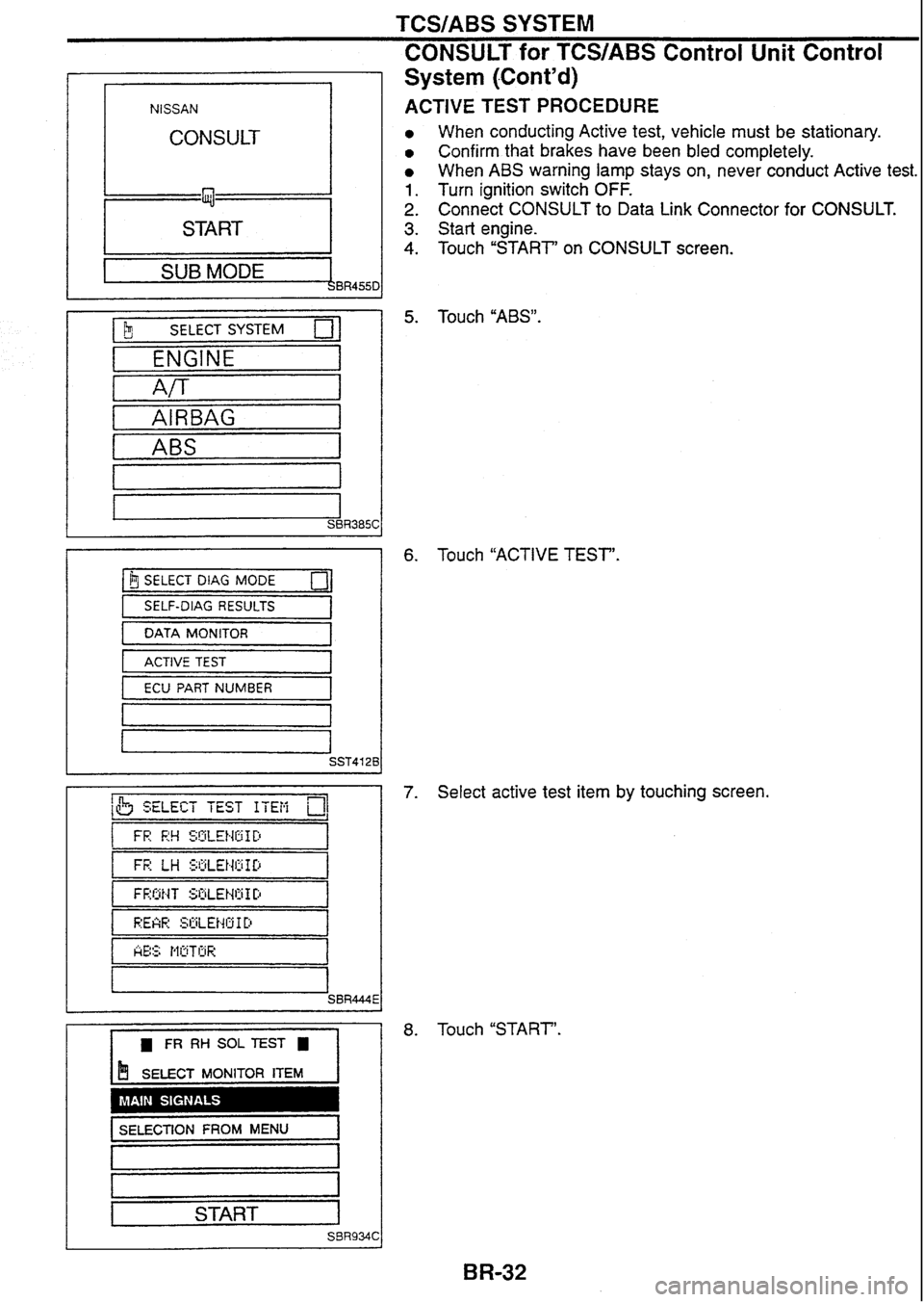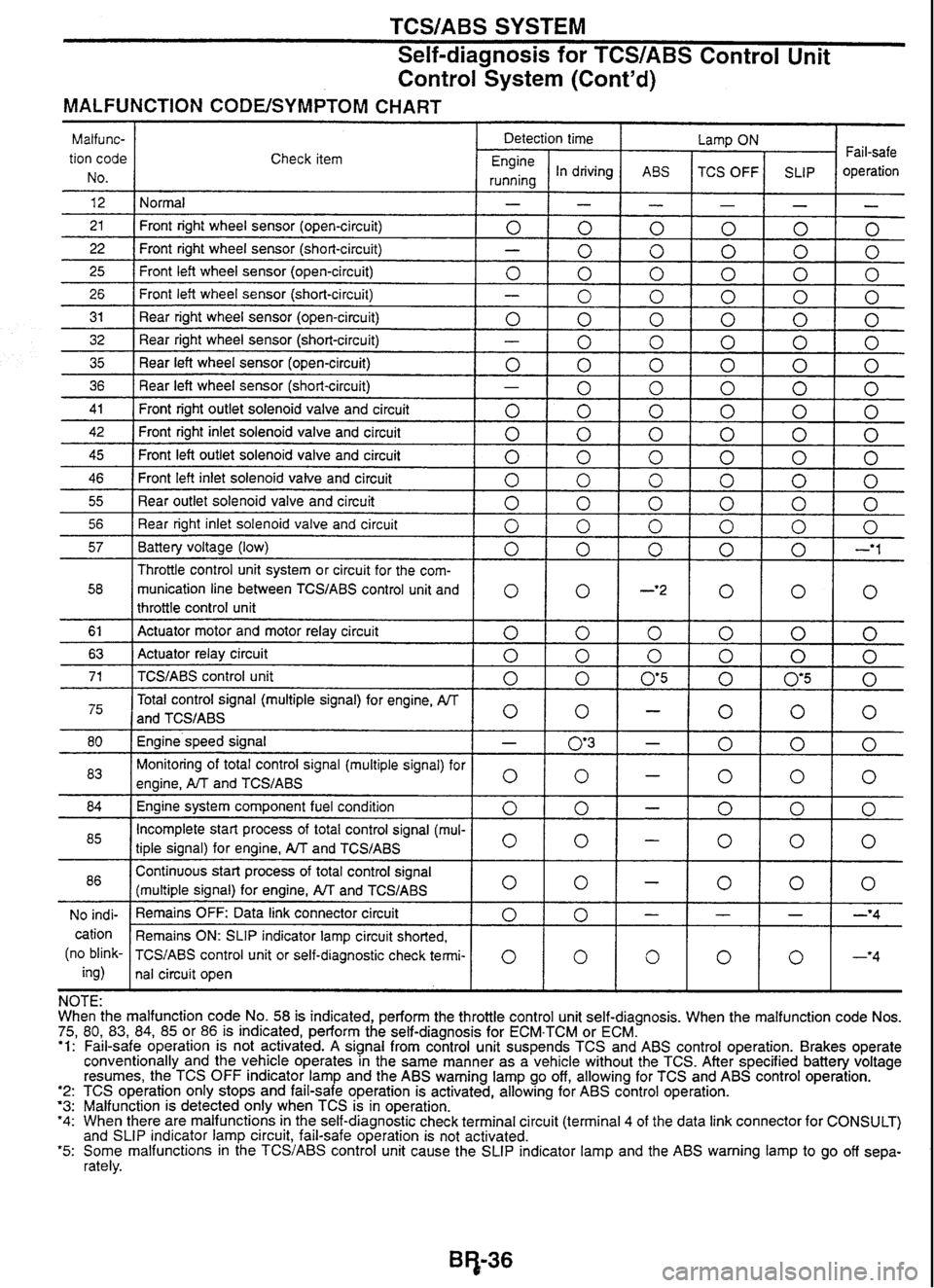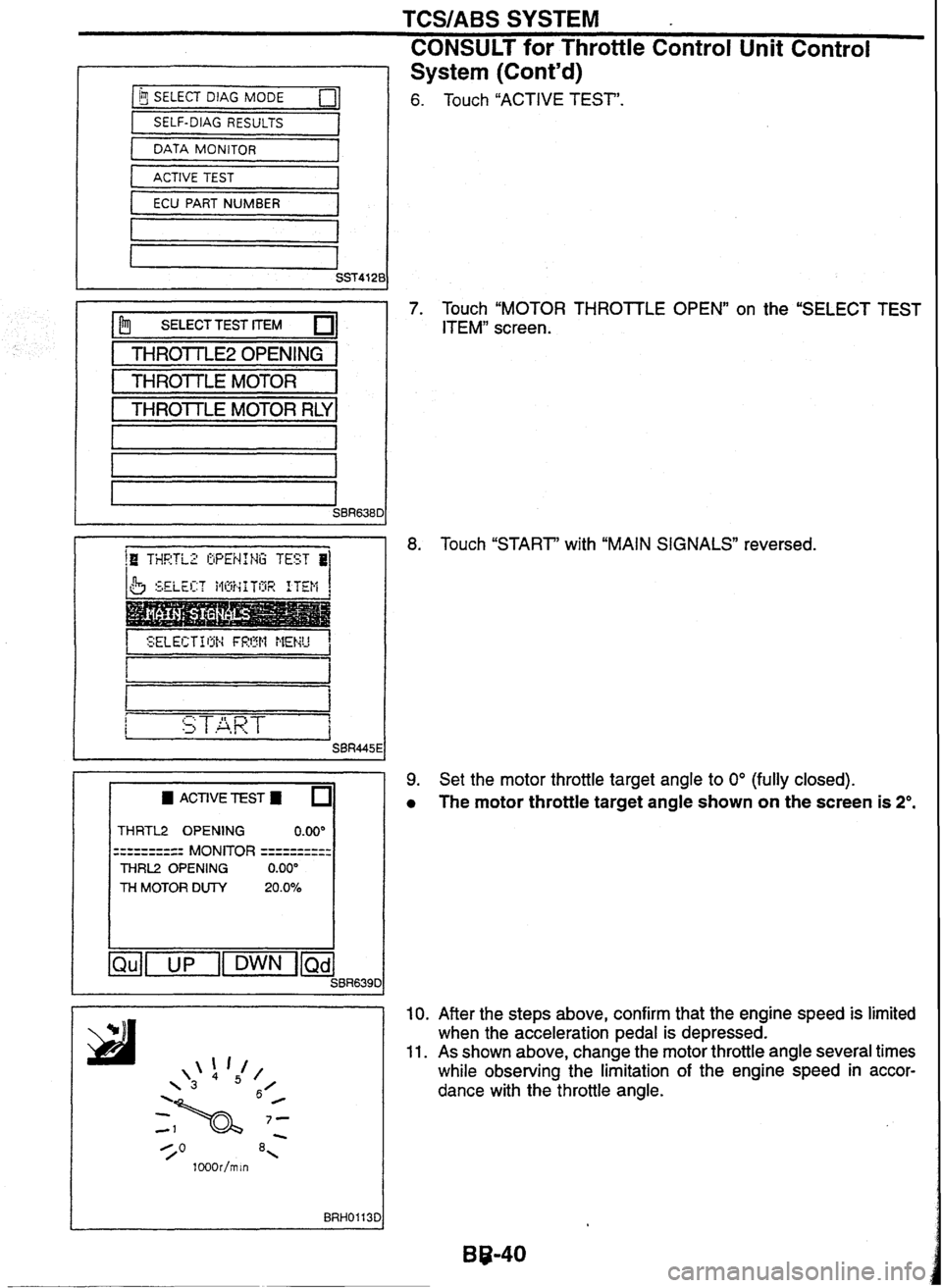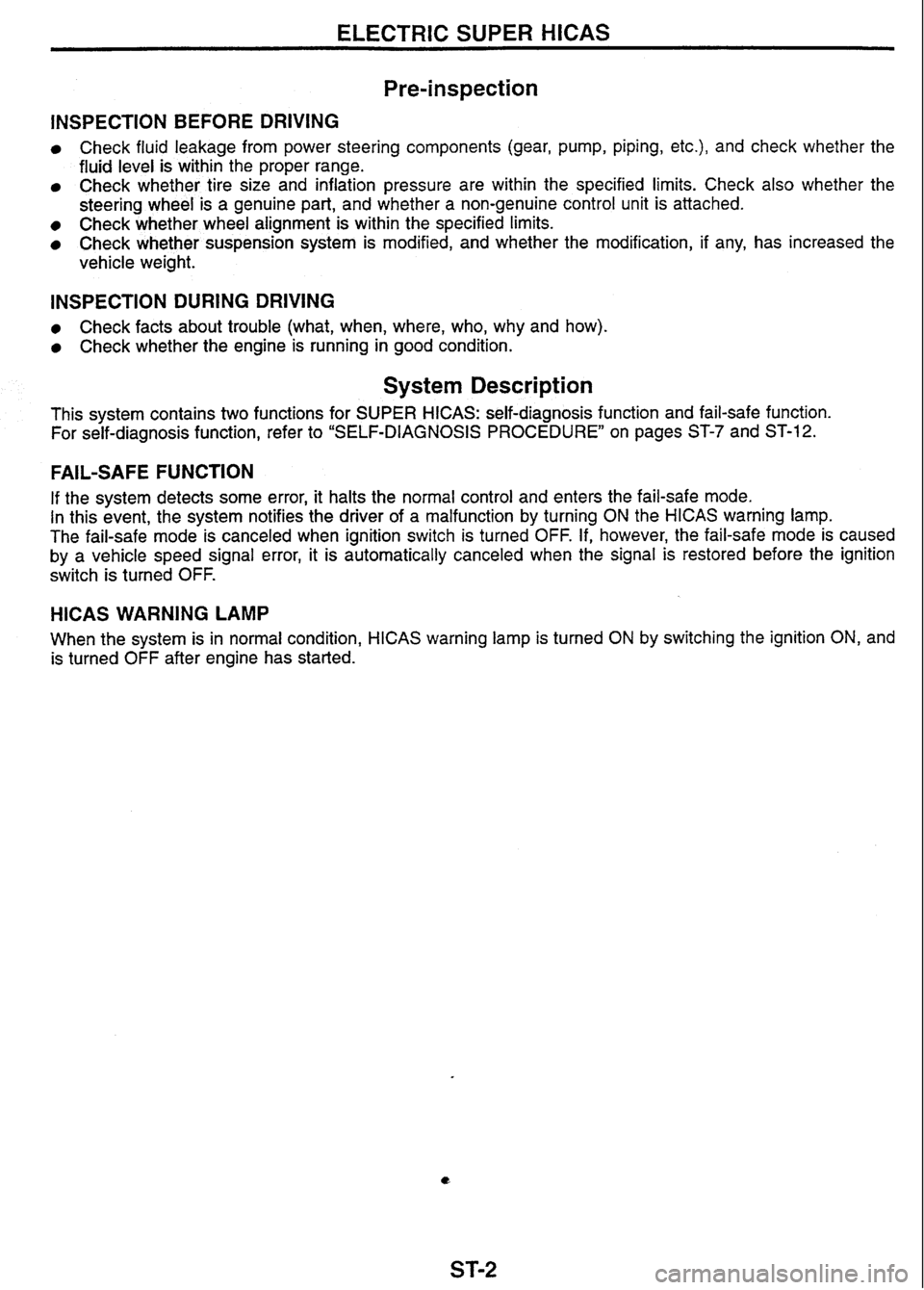engine NISSAN GT-R 1998 Owners Manual
[x] Cancel search | Manufacturer: NISSAN, Model Year: 1998, Model line: GT-R, Model: NISSAN GT-R 1998Pages: 230, PDF Size: 12.66 MB
Page 111 of 230

TCS/ABS SYSTEM
CONSULT for TCS/ABS Control Unit Control
CONSULT
START I
I I BR455D I SUB MODE
I SELECT SYSTEM
ENGINE
Arr
1 ABS I
I
[ $ SELECT DlAG MODE 01
SELF-DIAG RESULTS
DATA MONITOR
ACTIVE TEST
ECU
PART NUMBER
FR RH SOL TEST I
$ SELECT MONITOR ITEM
SELECTION FROM
MENU
u
START
System (Cont'd)
ACTIVE TEST PROCEDURE
When conducting Active test, vehicle must be stationary.
Confirm that brakes have been bled completely.
When ABS warning
lamp stays on, never conduct Active test.
Turn ignition switch OFF.
Connect CONSULT to Data Link Connector for CONSULT.
Start engine.
Touch "START' on CONSULT screen.
Touch
"ABS".
Touch "ACTIVE TEST'.
Select active test item by touching screen.
Touch "START'.
Page 113 of 230

TCS/ABS SYSTEM
Self-diagnostic check ter (Terminal 4 of data link c
Data link connector for CONSULT
Self-diagnosis for TCSfABS Control Unit
Control System
SELF-DIAGNOSIS PROCEDURE
1. Collect information on the concern from the customer, and then
perform basic inspections.
2. Drive vehicle at approx. 30 km/h for approx. 1 minute.
3. Stop vehicle and start diagnosis.
4. Turn ignition switch "OFF.
5. Ground the self-diagnostic check terminal 4 on the data link
connector for CONSULT.
6. Turn ignition switch "ON" to start the self-diagnostic results
mode.
CAUTION:
Keep terminal 4 grounded during self-diagnosis. Do not
depress brake pedal. Do not start engine. (Self-diagnosis
would
not start.)
When SLlP indicator lamp does not start blinking, check
TCSfABS
control unit power supply circuit and ground
circuit.
7. The SLlP indicator lamp starts blinking to indicate the malfunc-
tion code No.
3 or 4 seconds after the self-diagnostic results
mode is started.
The indication terminates after 5 minutes. Turning the igni-
tion switch from
"OFF" to "ON" resumes blinking the indi-
cation.
During the SLIP indicator lamp operation shown above,
TCS
OFF indicator lamp and ABS warning lamp are lit.
8. Vsrify the location of the malfunction with "MALFUNCTION
CODUSYMPTOM
CHART", BR-36. Then make the necessary
repairs.
9. After the malfunctions are repaired, erase the malfunction
codes stored
in the control unit. Refer to "HOW TO ERASE
SELF-DIAGNOSTIC RESULTS on the next page.
10. Rerun the self-diagnostic results mode to verify that the mal-
function codes have been erased.
When the malfunction codes have been erased, the start
code is only indicated.
11. Disconnect the check terminal from the ground. The self-diag-
nostic results mode is now complete.
12. Drive vehicle at approx. 30 km/h for approx. 1 minute, and then
check that the
TCS OFF indicator lamp, the SLlP indicator
lamp and the ABS warning lamp are OFF.
HOW TO READ SELF-DIAGNOSTIC RESULTS
(Malfunction codes)
Determine the code No. by observing the time and the fre-
quency that the SLlP indicator lamp flashes ON and OFF.
Refer to the next page.
When multiple malfunctions occur at a time, up to three code
numbers can
be stored; the latest malfunction will be indicated
first.
The indication begins with the start code No. 12. After that a
maximum of three code numbers appear in the order of the
latest one first. The indication then returns to the start code No.
12 to repeat.
The start code No.
12 is only indicated repeatedly when there
is no malfunction.
Page 114 of 230

TCS/ABS SYSTEM
Self-diagnosis for TCS/ABS Control Unit
control System (Cont'd)
Example: Code No. 25 Front left wheel sensor (open-circutt)
lnd~cat~on
start Start code No.
12
HOW TO ERASE SELF-DIAGNOSTIC RESULTS
(Malfunction codes)
1. Turn the ianition switch "ON" and start the engine.
ABS warnlng lamp - ON
ABS warning lamp
OFF
2. Drive the iehicle at approx. 30 km/h for appfox. 1 minute to
check that there
is no other malfunction.
3. Stop the vehicle and turn the ignition switch "OFF'. I88
4. Ground the self-diagnostic check terminal 4 on the data link
connector for CONSULT.
5. Turn the ignition switch "ONn to start the self-diagnostic results /,%@A
mode.
I---------- -------------- -?-I 3 06 0.9 03C303 3 3 06 3.6 06 09 030303030303030303
Unit: seconds BRG1185D
Tens drglts Units drgits Code No. 25
I -----l
7. Under the self-diagnostic results mode, the malfunction
memory erase mode starts when the check terminal
is discon-
nected from the ground.
8. Ground the check terminal 3 times or more in succession
-.
self-d~agnosts complete
SLlP ndicator lamp i
I ON r
f OFF - c 4 i
ground J Erase -- - - - - - - - - -i - - - - ---f2.i geconds-- - - - - - - .. t mode
Malfunct~on
memory
Malfunct~on
memory
IS erase mode starts. 1s erased. BRZOO~~D
within 12.5 seconds after the erase mode starts. (Each ground-
ing must be
2 seconds or longer.)
9. Disconnect the grounding cable from the check terminal to
erase the malfunction memory and complete the
self-diagno-
-----
CAUTION:
Keep terminal 4 grounded during self-diagnosis. Do not EL
depress the brake pedal during self-diagnosis. Do not start the
engine.
6. The SLIP indicator lamp starts blinking to indicate the malfunc- SD
tion code No. 3 or 4 seconds after the self-diagnostic results
mode is started.
The indication terminates after 5 minutes. Turning the igni-
tion switch from
"OFF" to "ON" resumes blinking the indi-
cation. During the SLlP indicator lamp operation shown
above,
TCS OFF indicator lamp and ABS warning lamp are
lit.
sis.
10. Rerun the self-diagnostic results mode to verify that the mal-
function codes have been erased.
0 When the malfunction codes have been erased, the start
code No.
12 is only indicated.
11. Disconnect the check terminal from the ground. The self-diag-
nostic results mode is now complete.
12. Drive vehicle at approx. 30 kdh for approx. 1 minute, and then
check that the
TCS OFF indicator lamp, the SLlP indicator
lamp
and the ABS warning lamp are OFF.
13. Turn the ignition switch "OFF.
Page 115 of 230

TCS/ABS SYSTEM
Self-diagnosis for TCSfABS Control Unit
Control System (Cont'd)
MALFUNCTION CODE/SYMPTOM CHART I I I
75, 'I:
'2: '3: '4:
'5:
Fail-safe operation is not activated. A signal from control unit suspends TCS and ABS control operation. Brakes operate
conventionally and the vehicle operates in the same manner as a vehicle without the TCS. After specified battery voltage
resumes, the TCS
OFF indicator lamp and the ABS warning lamp go off, allowing for TCS and ABS control operation.
TCS operation only stops and fail-safe operation is activated, allowing for ABS control operation.
Malfunction is detected only when TCS is in operation.
When there are malfunctions in the self-diagnostic check terminal circuit (terminal
4 of the data link connector for CONSULT)
and SLlP indicator lamp circuit, fail-safe operation is not activated.
Some malfunctions in the
TCS/ABS
control unit cause the SLlP indicator lamp and the
ABS warning lamp to go off sepa-
rately.
Malfunc-
tion code
No.
12
21 22
25
26
31
32
35
36
41
42
45
46
55
56
57
58
61
63
71
75
80
83
84
85
86
NO indi-
cation
(no blink-
ing)
NOTE:
When the
80, 83,
84, 85 or 86 is indicated, perform the self-diaqnosis for ECM-TCM or ECM.
Check
item
Normal
Front right wheel sensor (open-circuit)
Front right wheel sensor (short-circuit)
Front left wheel sensor (open-circuit)
Front left wheel sensor (short-circuit)
Rear right wheel sensor (open-circuit)
Rear right wheel sensor (short-circuit)
Rear left wheel sensor (open-circuit)
Rear left wheel sensor (short-circuit)
Front right outlet solenoid valve and circuit
Front right inlet solenoid valve and circuit
Front left outlet solenoid valve and circuit
Front left inlet solenoid valve and circuit
Rear outlet solenoid valve and circuit
Rear right inlet solenoid valve and circuit
Battery voltage (low)
Throttle control unit system or circuit for the corn-
munication
line between TCSIABS control unit
and
throttle control unit
Actuator motor and motor relay circuit
Actuator relay circuit
TCSIABS
control
unit
Total control signal (multiple signal) for engine,
IVT
and TCS/ABS
Engine speed signal
Monitoring of total control signal (multiple signal) for
engine,
AfT and TCS/ABS
Engine system component fuel condition
Incomplete start process of total control signal (mul-
tiple signal) for engine,
AfT and TCSIABS
Continuous start process of total control signal
(multiple signal) for engine, and
TCS/ABS
Remains OFF: Data link connector circuit
Remains ON: SLIP indicator lamp circuit shorted,
TCSIABS
control unit or self-diagnostic check termi-
nal circuit open
malfunction code No. 58 is indicated, perform the Detection
Engine
running
-
0 -
0
-
0 -
0 -
0
0
0
0
0
0
0
0
0
0
0
0
-
0
0
0
0
0
0
throttle control time
In driving
-
0
0
0
0
0
0
0
0
0
0
0
0
0
0
0
0
0
0
0
0 -
0'3
0
0
0
0
0
0
unit
a Fail-safe
operation
-
0
0
0
0
0
0
0
0
0
0
0
0
0
0
-'I
0
0
0
0
0
0
0
0
0
0
-'4
-'4
code Nos.
ABS
-
0
0
0
0
0
0
0
0
0
0
0
0
0
0
0
-*2
0
0
05
-
-
-
-
-
-
-
0
self-diagnosis. Lamp
ON
TCS OFF
-
0
0
0
0
0
0
0
0
0
0
0
0
0
0
0
0
0
0
0
0
0
0
0
0
0
-
0
When the SLlP
-
0
0
0
0
0
0
0
0
0
0
0
0
0
0
0
0
0
0
0'5
0
0
0
0
0
0
-
0
malfunction
Page 116 of 230

TCS/ABS SYSTEM
CONSULT for Throttle Control Unit Control
System
CONTROL UNIT PART NUMBER
The part number that is shown on the control unit label and CON-
SULT 23790 AA500
SELF-DIAGNOSIS PROCEDURE
Collect information on the concern from the customer, and then
perform basic inspections.
Turn ignition switch OFF and connect CONSULT connector to
data link connector for CONSULT on the vehicle.
sir
Start engine and drive vehicle at approx. 30 kmlh for approx.
1 minute.
Stop vehicle with engine running and touch "START',
Rs
"THROTTLE CONTROL" and "SELF-DIAG RESULTS"
sequentially on the CONSULT screen.
If "START" is touched immediately after engine is started !iIA
or ignition switch is turned on, "THRORLE CONTROL"
may not be displayed on "SELECT
SYSTEM" screen. To a
display "THROTTLE CONTROL", repeat the self-diagnosis
procedure from the beginning.
Self-diagnosis results are displayed on the screen. (Touch 8~ "PRINT" to print out the self-diagnosis results, if necessary.)
If "NO FAIL" is displayed, inspect SLIP indicator lamp, TCS
OFF indicator lamp, and ABS warning lamp. Refer to BR-26.
Perform appropriate inspection from the self-diagnostic results
mode and repair or replace faulty parts.
Start engine and drive vehicle at approx. 30
krn/h for approx.
1 minute to ensure that there is no other malfunction in the
system.
Turn ignition switch OFF to prepare for erasing the trouble
stored in memory.
Start engine and touch "START', "THROTTLE CONTROL",
"SELF-DIAG RESULTS" and "ERASE sequentially on the
CONSULT screen to erase the trouble stored in memory.
If the malfunction stored in memory is not erased, repeat
step
6.
10. Drive vehicle at approx. 30 km/h for approx. 1 minute and then !
confirm that TCS OFF indicator lamp and SLIP indicator lamp
is OFF.
Page 117 of 230

TCSIABS SYSTEM
CONSULT for Throttle Control Unit Control
System (Cont'd)
SELF-DIAGNOSTIC RESULTS MODE
- - Diagnostic item I Diagnostic item is detected when ... I Check item
THROTTLE
POSl
SEN
THROTTLE MOTOR Throttle
position sensor signal output is abnormally high or
continues to stay low for a certain period of time.
I
Throttle motor sensor signal output is abnormally high or con-
tinues to stay low for
a certain period of time. 1 Throttle motor sensor and circuit
Throttle
position sensor circuit
THRTL OPEN TRGET
THROTTLE ACTUATOR
RLY 1 Throttle motor relay is short-circuited.
[SHORT] Circuit
for throttle motor target angle signal (DKR line) is open
or shorted. TCS/ABS control unit
is abnormal.
Circuit for the communication
line between the throttle control
Throttle motor operation
does not accord with the throttle
motor target angle.
Throttle motor and circuit
I
ENGINE START SIG unit
and the TCSIABS control
unit
1 THROTTLE MOTOR
THROlTLE MOTOR RLY
[OPEN]
I Start signal is not correctiy entered due to short.
Overcurrent
is applied to the throttle motor drive circuit. I
Start signal circuit and
ECM-TCM or
ECM
Throttle motor relay is open.
Throttle motor relay and circuit
connector for
NEUTRAL POSl SW
DATA MONITOR PROCEDURE
Refer to CONSULT Instruction Manual for details on data
monitor function.
Turn ignition switch OFF.
Connect CONSULT connector to data link connector for
CON-
SU LT.
Turn ignition switch ON.
Touch "START' on CONSULT screen.
Touch ''THROTTLE CONTROL" on CONSULT screen.
Touch "DATA MONITOR".
Touch "SETTING" to set recording condition.
Touch one key from
"AUTO TRIG", "MANUAL TRIG" and
"SPECIAL", and then touch "LONG
TIME".
With "AUTO TRIG" selected, the data is automatically recorded
if a malfunction occurs during the data monitor. With "SPE-
CIAL" selected, the data is automatically recorded when TCS
is activated.
Touch "ENTER".
Return to
"SELECT MONITOR ITEM" screen and touch "ALL
SIGNALS". Display data monitor.
If necessary, sequentially touch "REC START', "REC STOP",
"DATA DISPLAY", "NUMBER
PRINT'
and "PRINT' to print
out
the data.
Bb38
Parkheutral position switch signal is not correctly entered due
to open or shorted circuit.
--
Neutral position switch circuit
and PNP switch circuit
Page 119 of 230

TCSIABS SYSTEM
CONSULT
for Throttle Control Unit Control
bJ SELECT DIAG MODE
SELF-DIAG RESULTS & I
DATA MONITOR 1
ACTIVE TEST I
ECU PART NUMBER I
I P?j SELECTTEST ITEM
I THROTIIEZ OPENING a
I THROTTLE MOTOR I
1 THROTLE MOTOR RLY 1
w ACTIVE TEST
THRTL2 OPENlNG 0.00" ---------- ---------- MONITOR ==========
THRL2 OPENING 0.00"
THMOTORDUTY 20.0°/0
System (Cont'd)
Touch "ACTIVE TEST".
Touch
"MOTOR THROSTLE OPEN" on the "SELECT TEST
ITEMn screen.
Touch "START' with "MAIN SIGNALS" reversed.
Set the motor throttle target angle to
0° (fully closed).
The motor throttle target angle shown on the screen is 2".
After the steps above, confirm that the engine speed is limited
when the acceleration pedal is depressed.
As shown above, change the motor throttle angle several times
while observing the limitation of the engine speed in accor-
dance with the throttle angle.
Page 120 of 230

TCSfABS SYSTEM
Self-diagnosis for Throttle Control Unit Control
System
SELF-DIAGNOSIS PROCEDURE
1. Turn ignition switch ON or start the engine to start self-diagnosis. g 2. The control unit LED comes on to indicate the malfunction code No.
3. Verify the location of the malfunction with "MALFUNCTION CODEISYMPTOM CHART", BR-42. Then
make the necessary repairs.
4. After the malfunctions are repaired, erase the malfunction codes stored in the control unit. Refer to "HOW EC
TO ERASE SELF-DIAGNOSTIC RESULTS" shown below.
5. Turn ignition switch OFF and then turn ignition switch ON or start the engine to verify that the malfunction AT
codes have been erased.
6. Verify that SLIP indicator lamp and TCS indicator lamp are OFF.
HOW TO READ SELF-DIAGNOSTIC RESULTS (Malfunction codes)
p
Determine the code No. by observing the time and the frequency that the throttle control unit LED blinks
ON and OFF. When multiple malfunctions occur at a time, all the code numbers can be stored. The indi-
cation begins with the start code
No. 12, followed by the stored malfunction codes. The smallest number
of the stored codes appears first and the others follow sequentially. The indication then returns to the start RS code No. 12 to repeat.
The malfunction code No. 55 is only indicated repeatedly when there is no malfunction.
P L / L -Z Code No. 12 Code No. 33 Unit: seconds BR90025D
Example: Code No. 12 and No. 33
0.6 0.3 0.6 0.3
HOW TO ERASE SELF-DIAGNOSTIC RESULTS (Malfunction codes)
I. With the throttle fully open, turn the neutral position switch OFF (or a position other than P and N).
2. Turn ignition switch-ON without starting the-engine. Then, turn the pa;k/neutral position switch ON (or P
or N} and release the acceleration pedal.
As for the following items, self-diagnostic results can be erased if the conditions in the chart are met. In
this case the steps above are not necessary.
(tens digit) '
ON
OFF
Malfunction code
No.
1-1-t-r- =i i 0.9 0.3 3.3 0.6 0.9-1 -' 3.3 To be repeated
-
\5
'c - (units digit) -1-
-
Malfunctioning part
Start signal circuit
-
Condition
Circuit for the communication line
(DKR line) between
the TCS control unit and the throttle control unit
The start signal is detected next time the ignition
switch is turned ON.
LCIW
-
Normal communication synchronicity is achieved.
ParWneutral
position switch circuit
dbr I
ParWneutral position switch operation is detected next
time the ignition switch is turned
ON.
- - -
--.
Page 123 of 230

ELECTRIC SUPER HICAS
INSPECTION BEFORE DRIVING
Check fluid leakage from power steering components (gear, pump, piping, etc.), and check whether the
fluid level is within the proper range.
Check whether tire size and inflation pressure are within the specified limits. Check also whether the
steering wheel is a genuine part, and whether a non-genuine control unit is attached.
Check whether wheel alignment is within the specified limits.
Check whether suspension system is modified, and whether the modification, if any, has increased the
vehicle weight.
INSPECTION DURING DRIVING
Check facts about trouble (what, when, where, who, why and how).
Check whether the engine is running in good condition.
System Description
This system contains two functions for SUPER HICAS: self-diagnosis function and fail-safe function.
For self-diagnosis function, refer to "SELF-DIAGNOSIS PROCEDURE on pages ST-7 and
ST-12.
FAIL-SAFE FUNCTION
If the system detects some error, it halts the normal control and enters the fail-safe mode.
In this event, the system notifies the driver of a malfunction by turning ON the HICAS warning lamp.
The fail-safe mode is canceled when ignition switch
is turned OFF. If, however, the fail-safe mode is caused
by a vehicle speed signal error, it is automatically canceled when the signal is restored before the ignition
switch is turned OFF.
HICAS WARNING LAMP
When the system is in normal condition, HICAS warning lamp is turned ON by switching the ignition ON, and
is turned OFF after engine has started.
Page 126 of 230

ELECTRIC SUPER HICAS
Control
Unit Input/Output Signal Specifications
USING CIRCUIT TESTER
Terminal No.
Check item Specification
When control unit is disconnected
: Continuity exists.
Control unit ground circuit
Motor driving output signal
When ignition switch is
ON : Power supply voltage
(In fail-safe mode
: OV)
Motor voltage
When vehicle speed is
0 krn/h : Approx. 4.4 - 6.6V
When vehicle speed is
100 km/h : Approx. 2.4 - 3.6V EPS solenoid driving signal
Battery voltage
I Power supply voltage
Data link connector for CONSULT
(TX) I -
Engine speed signal Measure
tachometer driving signal.
Refer to EC section YECM (TCM) Input/Output Signal
Reference
Value7
.
When ignition switch is ON : Power supply voltage
When ignition switch is OFF
: OV Ignition voltage
Body
/ ground HlCAS waming
lamp When HlCAS warning
lamp is ON
: Approx. OV
When
HlCAS
warning
lamp
is
OFF : Approx. 12V
When ignition switch is ON : Approx. 12V
(In fail-safe mode : Approx. OV)
Output
signal for driving motor relay
Data link connector for CONSULT
(RX) I -
Stop lamp switch signal
(Send brake pedal operation signal to control unit.) When
pedal is depressed : Power supply voltage
When
pedal is not depressed
: OV
Continuity exists.
v Steering angle sensor 2
Steering angle sensor 1
Body
ground When steering wheel
is turned, the voltage changes
between 0 and 5V.
Ground
circuit for rear steering angle sensor
Output signal of rear steering angle sensor
I When neutral : Approx. 2.4V
-
Neutral signal of rear steering angle sensor
When ignition switch is ON
When ignition switch is
OFF
--
When neutral : Appro~. 5V
: Approx. 5V
: Approx. OV Power supply for rear steering angle sensor